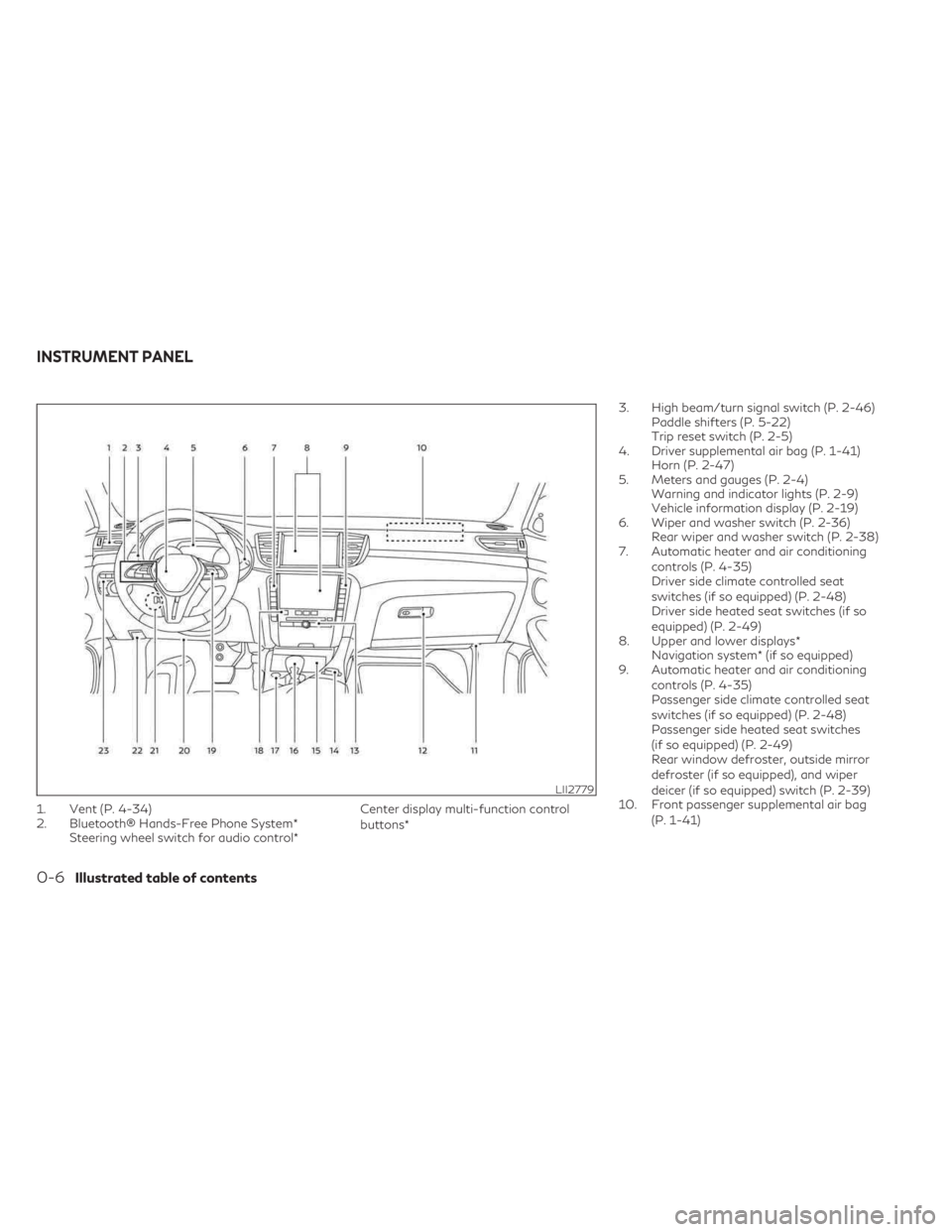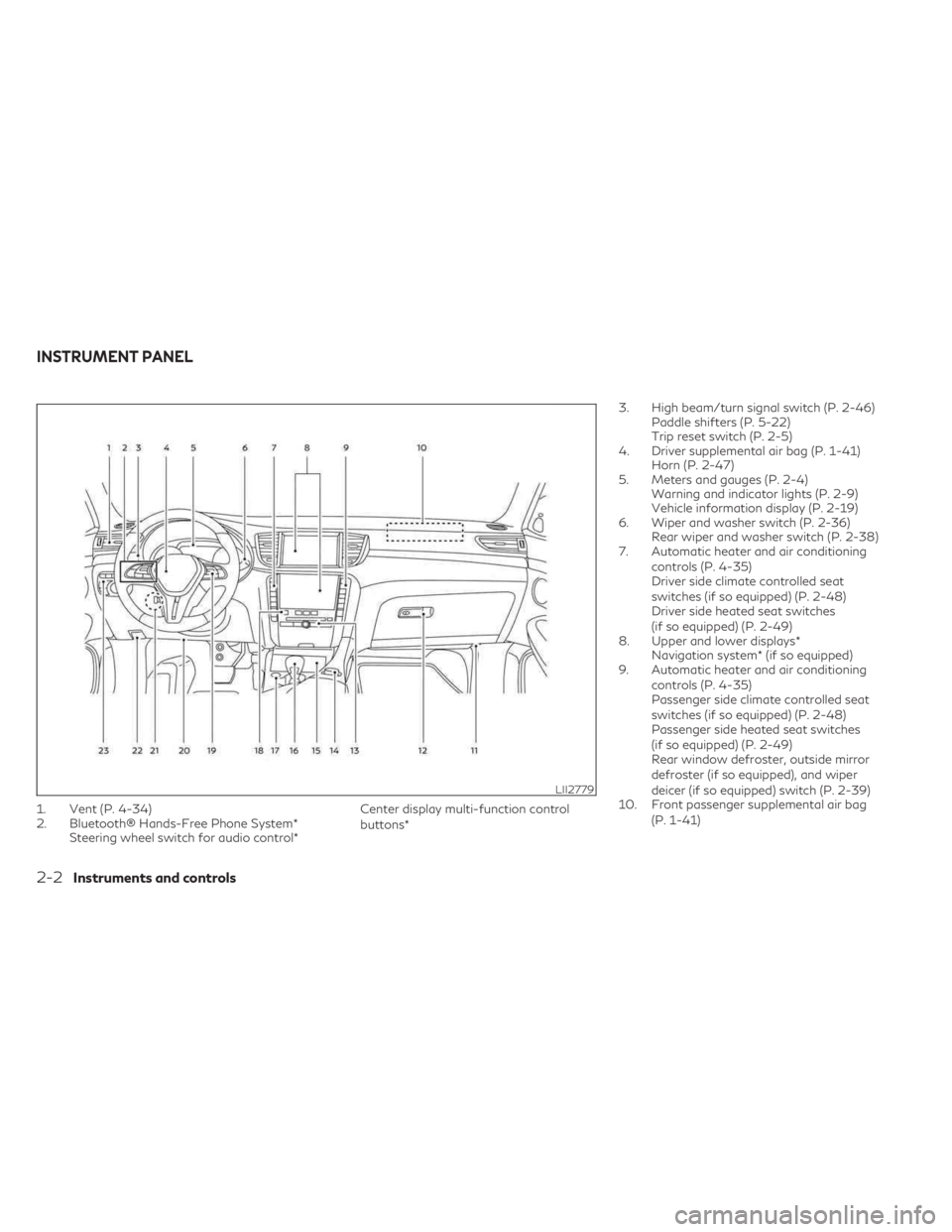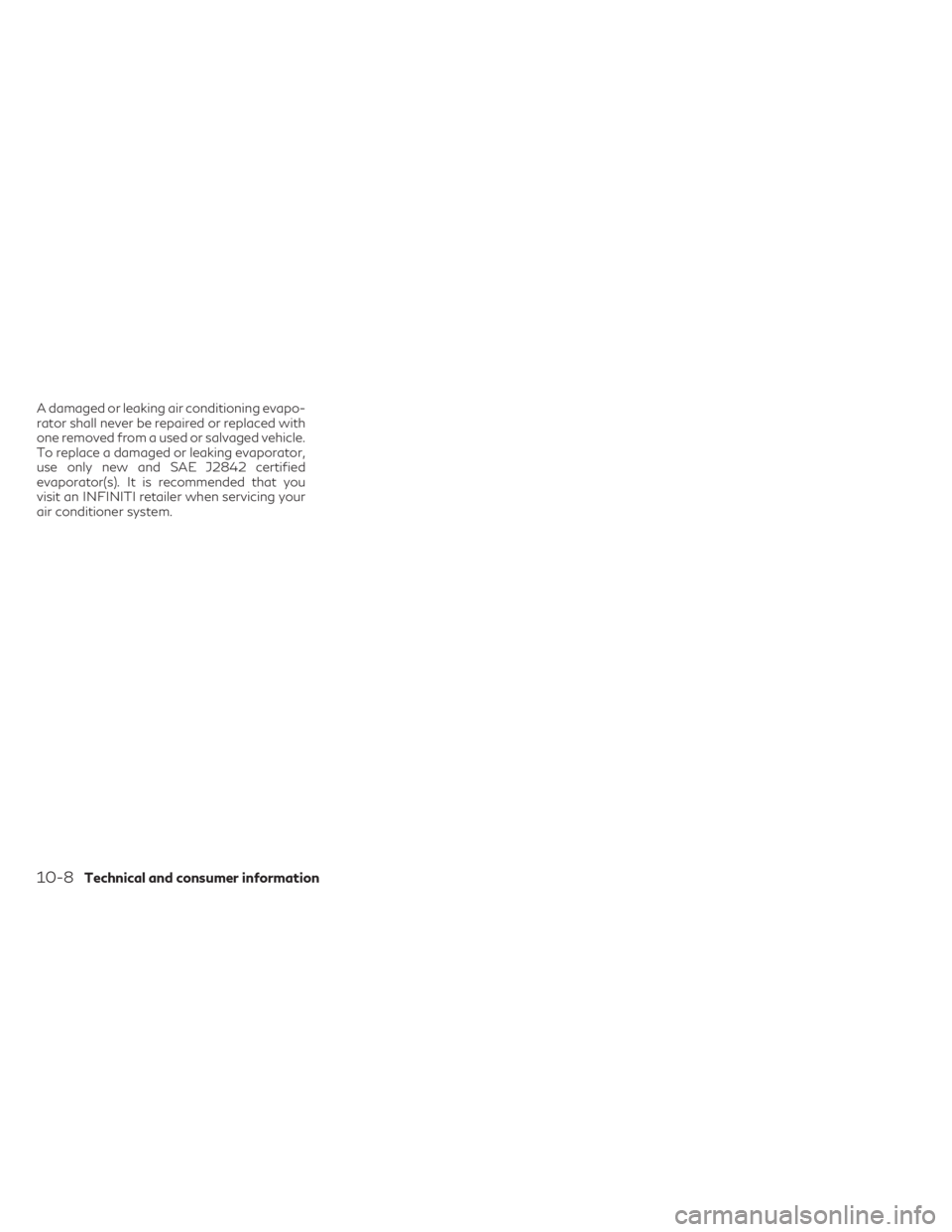air conditioning INFINITI QX50 2023 Owners Manual
[x] Cancel search | Manufacturer: INFINITI, Model Year: 2023, Model line: QX50, Model: INFINITI QX50 2023Pages: 548, PDF Size: 6.17 MB
Page 14 of 548

1. Vent (P. 4-34)
2. Bluetooth® Hands-Free Phone System*Steering wheel switch for audio control* Center display multi-function control
buttons*3. High beam/turn signal switch (P. 2-46)
Paddle shifters (P. 5-22)
Trip reset switch (P. 2-5)
4. Driver supplemental air bag (P. 1-41) Horn (P. 2-47)
5. Meters and gauges (P. 2-4) Warning and indicator lights (P. 2-9)
Vehicle information display (P. 2-19)
6. Wiper and washer switch (P. 2-36) Rear wiper and washer switch (P. 2-38)
7. Automatic heater and air conditioning
controls (P. 4-35)
Driver side climate controlled seat
switches (if so equipped) (P. 2-48)
Driver side heated seat switches (if so
equipped) (P. 2-49)
8. Upper and lower displays* Navigation system* (if so equipped)
9. Automatic heater and air conditioning
controls (P. 4-35)
Passenger side climate controlled seat
switches (if so equipped) (P. 2-48)
Passenger side heated seat switches
(if so equipped) (P. 2-49)
Rear window defroster, outside mirror
defroster (if so equipped), and wiper
deicer (if so equipped) switch (P. 2-39)
10. Front passenger supplemental air bag
(P. 1-41)
LII2779
INSTRUMENT PANEL
0-6Illustrated table of contents
Page 86 of 548

1. Vent (P. 4-34)
2. Bluetooth® Hands-Free Phone System*Steering wheel switch for audio control* Center display multi-function control
buttons*3. High beam/turn signal switch (P. 2-46)
Paddle shifters (P. 5-22)
Trip reset switch (P. 2-5)
4. Driver supplemental air bag (P. 1-41) Horn (P. 2-47)
5. Meters and gauges (P. 2-4) Warning and indicator lights (P. 2-9)
Vehicle information display (P. 2-19)
6. Wiper and washer switch (P. 2-36) Rear wiper and washer switch (P. 2-38)
7. Automatic heater and air conditioning
controls (P. 4-35)
Driver side climate controlled seat
switches (if so equipped) (P. 2-48)
Driver side heated seat switches
(if so equipped) (P. 2-49)
8. Upper and lower displays* Navigation system* (if so equipped)
9. Automatic heater and air conditioning
controls (P. 4-35)
Passenger side climate controlled seat
switches (if so equipped) (P. 2-48)
Passenger side heated seat switches
(if so equipped) (P. 2-49)
Rear window defroster, outside mirror
defroster (if so equipped), and wiper
deicer (if so equipped) switch (P. 2-39)
10. Front passenger supplemental air bag
(P. 1-41)
LII2779
INSTRUMENT PANEL
2-2Instruments and controls
Page 245 of 548

Voice Recognition logic (if so
equipped)
When the climate control system is on, the
fan speed may be automatically lowered so
that commands are more easily recognized.
Fan speed can be adjusted using the
fan
speed decrease andincrease buttons, if
desired.
MANUAL OPERATION
Fan speed control
Press thefan speed increase andfan speed decrease buttons to manually con-
trol the fan speed. Fan speed can also be
controlled by touching the “
”or“”
keys on the lower display.
Press the AUTO button to return to auto-
matic control of the fan speed.
Temperature control
Press thetemperature control
buttons up or down to set the desired
temperature.
The temperature can be set within the fol-
lowing range:
• For U.S.: 60 to 90°F (16 to 32°C)
• For Canada: 64 to 90°F (18 to 32°C)
Air recirculation
Press theair recirculation button to
recirculate interior air inside the vehicle. The
indicator light on the button will come
on.
The air recirculation cannot be activated
when the air conditioner is in the
front
defrosting mode.
When the outside temperature exceeds 70°F
(21°C), the air conditioning system may de-
fault to air recirculation mode automatically
to reduce overall power consumption. To exit
air recirculation mode, deselect the
air
recirculation button (indicator will turn off) to
enter fresh air mode.
Automatic intake air control
In the AUTO mode, the intake air will be
controlled automatically. To manually control
the intake air, press the
air recirculation
button. To return to the automatic control
mode, press and hold the
air recircula-
tion button for about 2 seconds. The indica-
tor light will flash twice, and then the intake
air will be controlled automatically.
Air flow control
Press thebutton to manually control air
flow. Pressing the button repeatedly will
cycle through the available modes and dis-
play the corresponding icon on the lower dis-
play. Air flow can also be controlled by touch-
ing the “
” key on the lower display:
— Air flows from center and side
vents.
— Air flows from center and sidevents and foot outlets.
— Air flows mainly from foot out-lets.
— Air flows from defroster andfoot outlets.
To turn system off
Press the ON-OFF button.
CLIMATE button
Press theCLIMATE button to show the
CLIMATE screen on the lower display.
Rear window and outside mirror
defroster switch
For additional information, see “Rear window
defroster, outside mirror defroster, and wiper
deicer switch” (P. 2-39).
Monitor, climate, audio, phone and voice recognition systems4-37
Page 247 of 548

CLIMATE SETTING SCREEN
Climate control settings can be changed on
the screen.
Available setting items may vary depending
on models and specifications.
Press the
CLIMATE button on the
lower display menu. The CLIMATE screen
will display on the lower display.
Heating (A/C off)
The air conditioner does not activate in this
mode. When you need to heat only, use this
mode.
1. Press the
CLIMATE button.
2. If the Climate system is off, press the ON-OFF button to turn the system on.
3. If the
A/C indicator is on, touch the
“A/C” key to turn the A/C off. 4. Press the
temperature control
buttons on the driver’s side to set the
desired temperature.
• When in AUTO mode, the temperature of the passenger compartment will be main-
tained automatically. Air flow distribution
and fan speed are also controlled
automatically.
• Do not set the temperature lower than the outside air temperature or the system may
not work properly.
• This procedure is not recommended if win- dows fog up.
When the outside temperature decreases to
approximately 32°F (0°C), the A/C function
does not activate even if the
A/C indi-
cator light illuminates.
Air conditioning (A/C)
Touch the “A/C” key to turn the A/C
mode on or off. Turn on the A/C mode for
effective cooling and dehumidifying. When
the A/C indicator light is on, the A/C mode
is on.
LHA5299
Type A (if so equipped)
LHA5457
Type B (if so equipped)
Monitor, climate, audio, phone and voice recognition systems4-39
Page 251 of 548

–– If the surface temperature of thesteering-wheel is above the temperature
within which the system is designed to
operate, the system will not heat the
steering-wheel. This is not a malfunction. The air conditioner system in your INFINITI
vehicle is charged with a refrigerant designed
with the environment in mind.
This refrigerant does not harm the earth's
ozone layer.
Special charging equipment and lubricant is
required when servicing your INFINITI air
conditioner. Using improper refrigerants or
lubricants will cause severe damage to your
air conditioner system. For additional infor-
mation, see “Air conditioner system refriger-
ant and oil recommendations” (P. 10-7).
It is recommended that you visit an INFINITI
retailer for servicing your “environmentally
friendly” air conditioning system.
WARNING
The air conditioner system contains refrig-
erant under high pressure. To avoid per-
sonal injury, any air conditioner service
should be done only by an experienced
technician with proper equipment.
ROOF MOUNTED ANTENNA
The antenna is located on the rear part of the
vehicle roof and an antenna pattern is printed
inside the rear window.
CAUTION
• A build-up of ice on the antenna can af-
fect radio performance. Remove the ice
to restore radio reception.
• When removing snow from the roof, do
not apply strong force to the antenna.
That may cause broken antenna and roof
panel dent.
• When using a high pressure car wash,
keep the high pressure nozzle away from
the antenna. The seal may be deformed
or damaged.
• The radio performance may be affected
if cargo carried on the roof blocks the
radio signal. If possible, do not put cargo
near the antenna.
•
Do not place metalized film near the rear
window glass or attach any metal parts to
it. This may cause poor reception or noise.
• When cleaning the inside of the rear win-
dow, be careful not to scratch or damage
the rear window antenna. Lightly wipe
along the antenna with a dampened soft
cloth.
SERVICING AIR CONDITIONER ANTENNA
Monitor, climate, audio, phone and voice recognition systems4-43
Page 386 of 548

CAUTION
During the first 1,200 miles (2,000 km),
follow these recommendations to obtain
maximum engine performance and ensure
the future reliability and economy of your
new vehicle. Failure to follow these recom-
mendations may result in shortened engine
life and reduced engine performance.
• Avoid driving for long periods at constant speed, either fast or slow, and do not run
the engine over 4,000 rpm.
• Do not accelerate at full throttle in any gear.
• Avoid quick starts.
• Avoid hard braking as much as possible.
• Do not tow a trailer for the first 500 miles (805 kilometers). Your engine, axle or other
parts could be damaged. Follow these easy-to-use Fuel Efficient Driv-
ing Tips to help you achieve the most fuel
economy from your vehicle.
1.
Use Smooth Accelerator and Brake Pedal
Application
• Avoid rapid starts and stops.
• Use smooth, gentle accelerator and brake application whenever possible.
• Maintain constant speed while com- muting and coast whenever possible.
2. Maintain Constant Speed
• Look ahead to try and anticipate and minimize stops.
• Synchronizing your speed with traffic lights allows you to reduce your number
of stops.
• Maintaining a steady speed can mini- mize red light stops and improve fuel
efficiency.
3. Use Air Conditioning (A/C) at Higher Ve-
hicle Speeds
• Below 40 mph (64 km/h), it is more efficient to open windows to cool the
vehicle due to reduced engine load.
• Above 40 mph (64 km/h), it is more efficient to use A/C to cool the vehicle
due to increased aerodynamic drag. • Recirculating the cool air in the cabin
when the A/C is on reduces cooling
load.
4.
Drive at Economical Speeds and Distances
•Observing the speed limit and not ex-
ceeding 60 mph (97 km/h) (where legally
allowed) can improve fuel efficiency due
to reduced aerodynamic drag.
• Maintaining a safe following distance behind other vehicles reduces unneces-
sary braking.
• Safely monitoring traffic to anticipate changes in speed permits reduced brak-
ing and smooth acceleration changes.
• Select a gear range suitable to road conditions.
5. Use Cruise Control
• Using cruise control during highway driving helps maintain a steady speed.
• Cruise control is particularly effective in providing fuel savings when driving on
flat terrains.
6. Plan for the Shortest Route
• Utilize a map or navigation system to determine the best route to save time.
BREAK-IN SCHEDULE FUEL EFFICIENT DRIVING TIPS
5-132Starting and driving
Page 501 of 548

Fluid TypeCapacity (approximate)
Recommended Fluids/Lubricants
Metric
Measure US
Measure Imperial
Measure
Multi-purpose grease —— — • NLGI No. 2 (Lithium Soap base)
Air conditioning system refrigerant —— —• HFO-1234yf (R-1234yf)
• For additional information, see “Air conditioner system refrigerant and
oil recommendations” (P. 10-7).
Air conditioning system oil —— —• Genuine NISSAN A/C System oil Type PAG (ND-OIL12) or equivalent
• For additional information, see “Air conditioner system refrigerant and
oil recommendations” (P. 10-7).
Windshield-washer fluid 5 L 1–3/8 gal 1–1/8 gal• Genuine NISSAN Windshield Washer Concentrate Cleaner & Anti-
freeze fluid or equivalent
Technical and consumer information10-3
Page 506 of 548

A damaged or leaking air conditioning evapo-
rator shall never be repaired or replaced with
one removed from a used or salvaged vehicle.
To replace a damaged or leaking evaporator,
use only new and SAE J2842 certified
evaporator(s). It is recommended that you
visit an INFINITI retailer when servicing your
air conditioner system.
10-8Technical and consumer information
Page 512 of 548

Symbol NameReferenceGraphic
Caution ISO 7000 0434
Air Conditioning System
(MAC)ISO 2575 D01
MAC System Lubricant Type
(PAG–POE)
Requires Registered Technician to
Service MAC System
Flammable Refrigerant
Air Conditioner Specification Label Symbols 1. From the front of the vehicle find the cen-
terline of the front fascia. Measure down-
wards from the gap between the grille and
the outer bezel and bumper fascia 3.46 in
(81 mm). Mark the location on the fascia.
2. Drill a 0.47 in (12 mm) hole
OAin the
fascia.
LTI2594
Type A (if so equipped) (Except sport model)
INSTALLING FRONT LICENSE PLATE
10-14Technical and consumer information